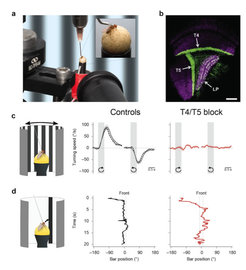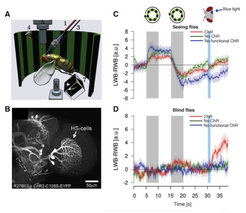Tethered Behavior

a Setup for walking analysis. The fly is running on a small air suspended Styrofoam ball looking at a set of computer monitors. In the back of the fly a set of computer-mouse sensors is used for tracking the rotation of the ball. b Gal4 line with strong expression in T4 and T5 cells used in the experiments. c Optomotor essay. The fly is presented with grating rotating clockwise or counterclockwise. Normal flies turn in the direction of pattern movements, while T4/T5 block flies do not respond at all. d Fixation essay. The fly is presented with a black bar which position it can control. Normal flies quickly bring the bar the front and keep it there, as do flies with T4/T5 neurons blocked. The image in a was taken by Robert Schorner (MPIN), the image in b and c were modified from Schnell et al., 2012 and Bahl et al., 2013, respectively.
The ultimate output of the brain is behavior. On the one hand, behavior can be used as a convenient readout for neural computation, for instance local motion detection. On the other hand, it illuminates the significance of the neural computation under investigation, for instance course control by higher-order visual neurons.
To study behavior in a highly-controlled fashion, we tether flies to a rod and monitor locomotion using two complementary systems: 1) we track the movements of the two wings and calculate the difference between wing beat amplitudes which provides us with the information into which direction the fly is steering; 2) to study walking behavior, we place an air-suspended Styrofoam ball under the fly on which it can walk like on a treadmill. We use a system of computer-mouse sensors tracking the rotation of the ball to measure turning and walking speeds. Since flies will try to follow a moving pattern, termed the optomotor response, the requirement and roles of neurons in this visual behavior can be readily addressed using genetic circuit manipulations.
When flies are presented with a rotating pattern they respond with a turning response in the direction of pattern motion. This behavior is called the optomotor response and thought to reflect an animal’s tendency to stabilize its course under natural conditions (Heisenberg & Wolf, 1984). Using the experimental setup with walking flies we have found that medulla neurons T4 and T5 are necessary elements for that behavior (Schnell et al., 2012; Bahl et al., 2013): Flies with T4 and T5 output blocked did not perform an optomotor response anymore, since they were blind to the movement of the pattern. However, these flies were not completely blind: In a different scenario flies were permitted to fixate and track a black bar. Normal flies do this reliably and quickly bring the bar to the front and keep it there. To our surprise, this behavior was still intact in flies with T4 and T5 neurons blocked. This shows that tracking behavior is controlled by a different neuronal pathway than the one used in motion vision.

The large tangential cells in the Lobula Plate are postsynaptic to T4 and T5 neurons and collect information from many visual columns. From electrophysiological recordings, it is known that tangential cells respond robustly and in a direction selective manner to visual motion stimulation. HS cells, for instance, are depolarized by front-to-back motion and hyperpolarized by back-to-front motion. Therefore, their signals are thought to mediate corrective yaw turning, for instance when the visual panorama moves across the retina due to an involuntary turn. To provide experimental evidence for this idea, we expressed Channelrhodopsin in HS cells and measured the consequences of their unilateral activation in blind tethered flying flies (Haikala et al., 2013). Flies responded with turning towards the side of activation and therefore syn-directional with the mimicked visual motion. This outcome strengthens the notion that tangential cell activity influences steering in order to support course stabilization.
References
Bahl, A., Ammer, G., Schilling, T. & Borst, A. Object tracking in motion-blind flies. Nat. Neurosci. 16, 730–738 (2013).
Haikala, V., Joesch, M., Borst, A. & Mauss, A. S. Optogenetic Control of Fly Optomotor Responses. J. Neurosci. 33, 13927–13934 (2013).
Heisenberg, M. & Wolf, R. Vision in Drosophila. (Springer, Berlin, Heidelberg, New York, Tokyo, 1984).
Schnell, B., Raghu, S. V., Nern, A. & Borst, A. Columnar cells necessary for motion responses of wide-field visual interneurons in Drosophila. J. Comp. Physiol. A 198, 389–395 (2012).

